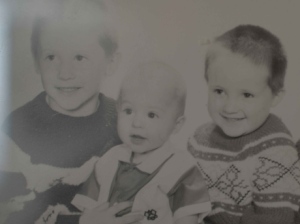Granny Smith Investigates was my first book in the Granny Smith series and it's done pretty well - I'm pleased with the way it has gone down with strong sales and good reviews. The book is now also available as an eBook from those nice people at Audible. Performed by Fiona Thraille you can check out a sample reading by clicking HERE
There's a brutal murder in the small Welsh
village of Gilfach. The police are clueless. With no motive and no real
suspect, the investigation soon grinds to a halt. Enter Mary Anne Smith,
otherwise known as Granny Smith, the 71-years-young, pipe-smoking,
heavy metal-loving, chaos-causing amateur sleuth with a difference.
Granny has a talent for mayhem, and soon those talents are put to good use as our intrepid pensioner starts the unravel the case, which finds her provoking Chief Inspector Miskin as she comes up against a full scale police investigation, proving that you're never too old to make a nuisance of yourself and that 71 is actually the new 21.
Murder's never been so much fun.
If you like crime novels, particularly cozy crimes than this title should be right up your street. Then again I believe the characters are so wide ranging and comedic that anyone who takes the plunge will find much to enjoy in the title. Well I would say that, after all I am the creator of Granny Smith but there have been four books about the character, with several more to come so I must enjoy writing about her, the world she inhabits muse seem real to me. Is Granny my favourite of all my characters? Well I'm going to become all precious now and say that all my characters are equal to me, they are all my babies but then again Granny came kicking and screaming, fully formed from my imagination.
'The eccentric Welsh pensioner gets her teeth (usually gripping a corn-cob pipe) into solving the mysterious murder of a friend in the village. Despite being ignored and warned off by the police, she persists. This delightful story makes great family reading with plenty of humour. I can just imagine a nice TV comedy series from this.' *****
Actress, Fiona Thraille has done a wonderful job in performing the book - note I say performing rather than reading, because Fiona does an incredible job in bringing the characters to life. The actress will soon start work on the second Granny Smith title so if you enjoy the first one, and I'm confident you will, then you'll have another title to look forward to.
"A delightful story with an unpredictable plot, remarkable characters, zany happenings that combine for an engaging light hearted read. Granny Smith, named after the apple convincingly morphs into "Miss Marple on steroids".*****
If you don't have an Audible account then you can sign up for a trial and get Granny Smith Investigates for free - simply select the title for your free title. Find out how HERE .
You can, of course, hear a free audio sample before you decide to buy so you've really got nothing to lose by checking out Audible.
'It had been a while since I have read the likes of the character Miss Marple from Agatha Christie works. Now Granny Smith has fulfilled that void in my reading life. Granny Smith is not exactly old to be a Granny by heart but irrespective of that, everyone has been calling her Granny. She is a young at heart woman who has a trait to be curious about everything that is happening around her. So when her friend Sheila gets engaged to Nigel, who is younger than her, Granny Smith gets suspicious. The following murder in the town makes Granny even more curious and on she follows the clues of the murder, much to the chagrin of Detective Inspector Miskins.' *****
Granny has a talent for mayhem, and soon those talents are put to good use as our intrepid pensioner starts the unravel the case, which finds her provoking Chief Inspector Miskin as she comes up against a full scale police investigation, proving that you're never too old to make a nuisance of yourself and that 71 is actually the new 21.
Murder's never been so much fun.
If you like crime novels, particularly cozy crimes than this title should be right up your street. Then again I believe the characters are so wide ranging and comedic that anyone who takes the plunge will find much to enjoy in the title. Well I would say that, after all I am the creator of Granny Smith but there have been four books about the character, with several more to come so I must enjoy writing about her, the world she inhabits muse seem real to me. Is Granny my favourite of all my characters? Well I'm going to become all precious now and say that all my characters are equal to me, they are all my babies but then again Granny came kicking and screaming, fully formed from my imagination.
'The eccentric Welsh pensioner gets her teeth (usually gripping a corn-cob pipe) into solving the mysterious murder of a friend in the village. Despite being ignored and warned off by the police, she persists. This delightful story makes great family reading with plenty of humour. I can just imagine a nice TV comedy series from this.' *****
Actress, Fiona Thraille has done a wonderful job in performing the book - note I say performing rather than reading, because Fiona does an incredible job in bringing the characters to life. The actress will soon start work on the second Granny Smith title so if you enjoy the first one, and I'm confident you will, then you'll have another title to look forward to.
"A delightful story with an unpredictable plot, remarkable characters, zany happenings that combine for an engaging light hearted read. Granny Smith, named after the apple convincingly morphs into "Miss Marple on steroids".*****
If you don't have an Audible account then you can sign up for a trial and get Granny Smith Investigates for free - simply select the title for your free title. Find out how HERE .
You can, of course, hear a free audio sample before you decide to buy so you've really got nothing to lose by checking out Audible.
'It had been a while since I have read the likes of the character Miss Marple from Agatha Christie works. Now Granny Smith has fulfilled that void in my reading life. Granny Smith is not exactly old to be a Granny by heart but irrespective of that, everyone has been calling her Granny. She is a young at heart woman who has a trait to be curious about everything that is happening around her. So when her friend Sheila gets engaged to Nigel, who is younger than her, Granny Smith gets suspicious. The following murder in the town makes Granny even more curious and on she follows the clues of the murder, much to the chagrin of Detective Inspector Miskins.' *****







 upon
which to build a story, but it was certainly the most influential.
Almost immediately following it first hitting the servers, scores of
other podcasts immediately sprung up, hoping to emulate
upon
which to build a story, but it was certainly the most influential.
Almost immediately following it first hitting the servers, scores of
other podcasts immediately sprung up, hoping to emulate 

 Finally a podcast that has got my attention recently is,
Finally a podcast that has got my attention recently is, 







